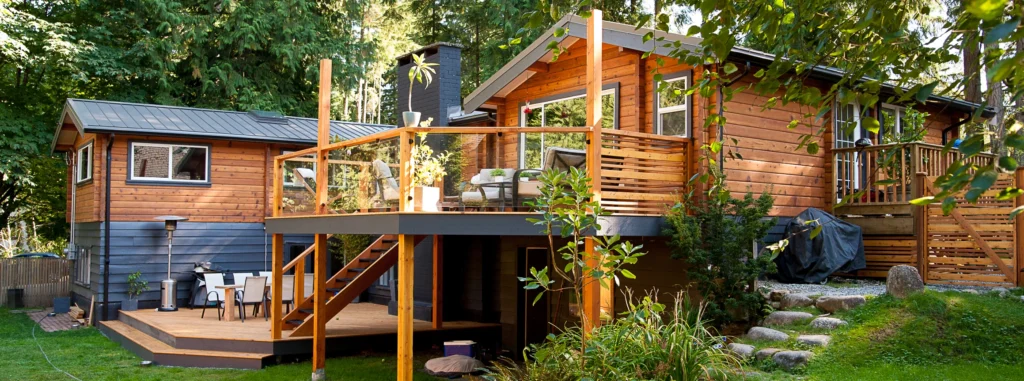3 Comprehensive Guides to Stain Products

Choosing the right stain product is critical when staining your deck, fence, or outdoor woodwork. With numerous products available in the market, deciding on the right type can be overwhelming. In this comprehensive guide, we’ll delve into the most popular products: natural stain, semi-transparent stain, and solid color stain. Discover the benefits and uses of each type so you can make an informed decision for your next project. By selecting the right product, you can protect and enhance the natural beauty of your woodwork while ensuring its longevity and durability.
Natural Stain Pattern
This natural wood stain enhances wood's beauty while protecting it from weathering. Made from plant oils and resins, it highlights the wood's natural color, creating a warm, rich finish. Ideal for outdoor use, it's breathable, eco-friendly, and non-toxic . This is ideal for outdoor woodwork such as decks, fences, and siding,
Semi-Transparent Stain
Semi-transparent wood stains add color while showcasing the natural grain and texture. They penetrate wood, protecting against moisture, mildew, and outdoor elements, and come in various shades. Ideal for decks, fences, and outdoor woodwork, they offer a natural look and are easy to apply and maintain.
Solid Color Stain
Solid color stains offer an opaque finish, concealing the wood's grain and imperfections. Ideal for weathered wood, they provide a uniform look and protection against UV rays, moisture, and mildew. Available in a variety of colors for a personalized finish. heavily weathered or has imperfections
Residential | Commercial | Industrial
Staining a Log House
Staining a log house protects the wood from weathering and rotting while enhancing its natural beauty. With many products available, choosing the right one can be challenging. This guide covers the benefits of staining and provides tips for preparation and application.
Staining a log house has numerous benefits, including:
Protection:
Products that contain UV blockers and fungicides that protect the wood from weathering, rotting, and insect damage.Aesthetics:
Staining can enhance the natural beauty of the logs, adding depth and richness to the color.Longevity:
A good layer can increase the lifespan of the logs, reducing the need for costly repairs and replacements. However, the coating must not be too thick and runny.

Clear Stain / Transparent
The clear stain is transparent, showcasing the wood’s natural color and grain. It offers minimal protection but is ideal for a natural look
Semi-transparent Stain
- Semi-transparent materials are a slightly opaque product that allows some of the natural color and grain to show through. It provides moderate protection from the elements and can be a good option if you want a balance between a natural look and protection.
Solid Color Stain
- Solid color stain is an opaque product that completely covers the natural color and grain of the wood. It provides the highest level of protection from the elements and can be a good option if you want to change the color of the logs or cover up imperfections.
Preparing for Staining
Before you start staining, it’s important to properly prepare the logs.
- Clean the logs:
Use a pressure washer or a stiff-bristled brush to remove dirt, grime, and debris from the logs.
Sand the logs:
Use a palm sander or a sanding block to smooth out any rough spots or splinters on the logs.
Apply a wood cleaner:
Use a wood cleaner to remove any remaining dirt or stains from the logs.
Let the logs dry:
Allow the logs to dry completely before applying the stain.
Applying the Stain
Here are the steps for applying stain to the surface
- Choose a dry, overcast day: Avoid staining on a hot, sunny day, as the heat can cause the it to dry too quickly.
- Protect the surrounding area: Cover any nearby plants or furniture with a tarp or plastic sheeting to protect them from the stain.
- Apply the stain: Use a brush or a sprayer to apply in thin, even coats. Be sure to follow the manufacturer’s instructions for drying time and the number of coats.
Conclusion
Staining a log house is an important maintenance task that helps to protect the wood from weathering and rotting. With the right product and proper preparation, you can enhance the natural beauty of your logs while ensuring their longevity and durability.
Study the steps outlined in this guide to get the best results. Understanding the differences of solid color stain, Semi-transparent stain or clear other words called Transparent stain is critical to the finish you will have.
The preparation of the surface is also another crucial step for the wood surface as wood is very delicate and it can easily burn or get damaged. We highly recommend on-hand sanding and once you are comfortable than you can use belt sander.
Our Top-Rated Exterior Commercial Property Reviews
Cedar siding: Popular in Canada, naturally resistant to rot, lightweight, and has a beautiful grain that can be stained or painted. Ideal for high-moisture areas.
Spruce siding: Affordable, lightweight, and easy to work with. It can be stained or painted but may not be as durable in moist conditions.
Fir siding: Durable and resistant to decay, with a straight grain for a clean, uniform look. Ideal for high-moisture areas.
Pine siding: Affordable and easy to work with but less durable than cedar or fir. Can be stained or painted with proper maintenance.
Other options: Hemlock, cypress, and redwood offer unique characteristics and benefits based on preferences, budget, and climate.
Reclaimed wood: A growing trend, offering a unique, rustic look and an environmentally friendly option.
Most common choices: Cedar and spruce are the most widely used due to availability, affordability, and ease of use.
Maintenance: Proper care ensures wood siding lasts for many years, making it a popular choice for Canadian homes.






